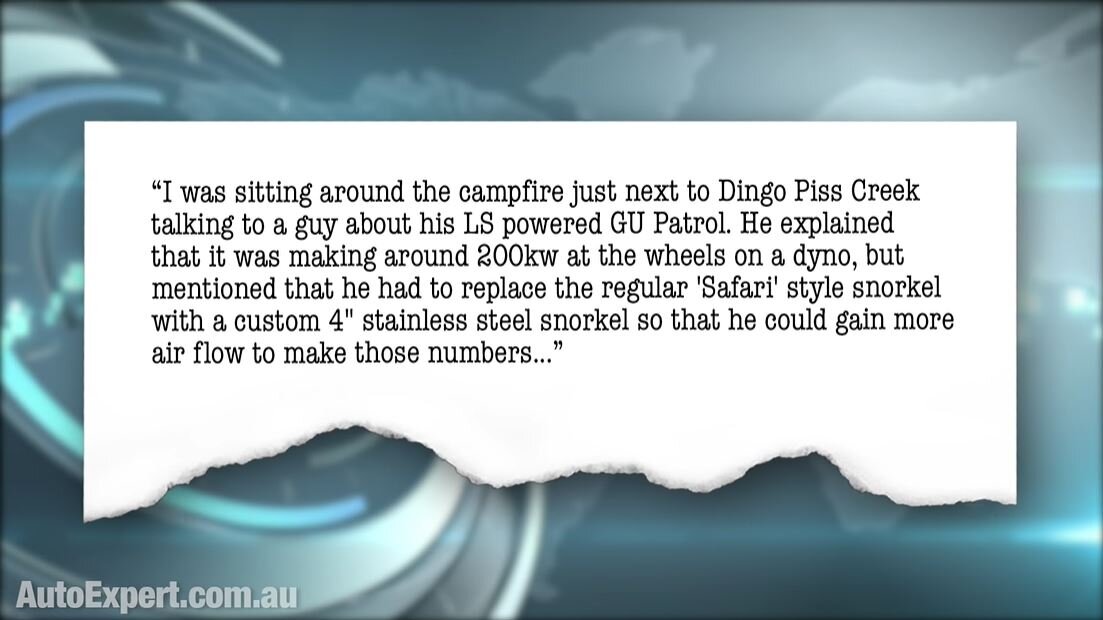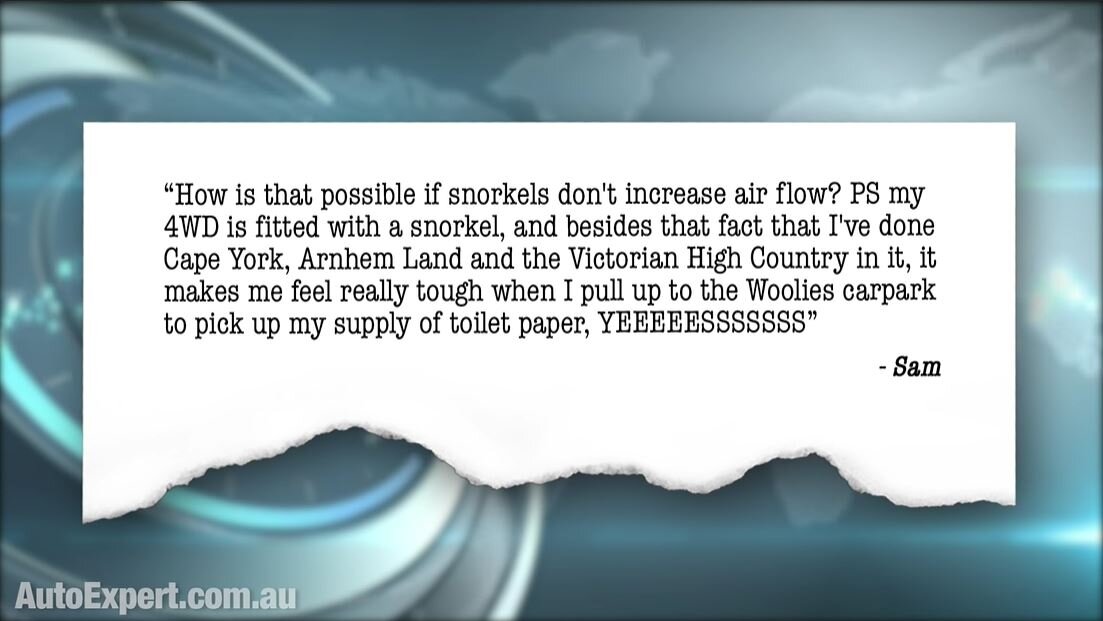4WD Snorkels and increasing engine airflow (your Q&A - contains nuts)
A 4X4 question from one of my favourite humans - a beard-stroking blue-singlet bogan who (most probably) spent most of his early life asleep at school. And today, they vote…
This report started from my previous one, 4X4 Snorkels: Ultimate Buyer's Guide (you probably don't need one) >>
So begin there if you haven’t seen it first. If you’re a full-blown snorkel enthusiast, you might want to brace for impact…
I love it when ‘civilians’ attempt to poke holes in basic engineering arguments.
Like, mate - never studied Bernoulli, Pascal, Newton or D’lamert - didn’t need it - but happy to have a crack with airflow. How hard can it be?
Sam, ‘airflow’ is one word. That’s important, dude, if that’s the central issue about which your ‘thesis’ orbits.
In an earlier report, I did allege, using facts, that snorkels are mostly a bullshit waste of money, bordering on being a complete blue-singlet wank, unless you actually drive through water deeper than the standard air inlet.
The responses were fascinating, frankly. Some of you alleged it’s less dusty up there, 18 inches higher than the standard air intake. It’s not.
Some of you told me the air is cooler up there because you’re not sucking it from the hot engine bay. It’s not. Engines don’t do that. There’s either a scoop out in front of the radiator and over the top, under the hood, or at the side of the headlamp, or inside the inner guard. So the inlet air does not come from inside the engine bay, unless your wanking chariot rolled off the line when the T-Rex was still with us.
And even if your chariot is doing only 40 kays an hour, it’s travelling its own length roughly twice every second - that’s a fairly substantial airflow of cooler air into the standard inlet. So there’s that.
Overall I found a subset of the comments on this to be quite entertaining attempts to justify one of the pre-eminent ‘ultimate wank’ 4X4 modifications - but Sam’s was the best. By far. Two bearded chaps, staring into the fire, stroking… Good times.
USEFUL LINKS FOR OFF-ROADING, RECOVERY AND EQUIPMENT
Rhino 4X4 roof rack: Why I didn't buy one >>
Essential guide to 4WD tyre pressures and related 4X4 driving basics >>
Basic safe 4WD recovery rules for off-road adventuring >>
Hard shackles -Vs- soft shackles in 4WD recovery >>
Are GVM upgrades a good idea? >>
The most common off-road driving mistake (and how to avoid it) >>
My AutoExpert AFFORDABLE ROADSIDE ASSISTANCE PACKAGE
If you’re sick of paying through the neck for roadside assistance I’ve teamed up with 24/7 to offer AutoExpert readers nationwide roadside assistance from just $69 annually, plus there’s NO JOINING FEE
Full details here >>
Major vehicle modifications: Done right VS potential disaster
Jamming GM’s LS V8 into a shitbox Nissan GU Patrol is one of the more compelling hardcore 4X4 mods - nice choice, dude. Another ‘teepee in the trouser’ DIY mod for sure.
Marks4wd.com does an awesome bellhousing, input shaft extension, and GM clutch adapter for your clapped-out 4.8 Nissan straight six. Just $3650. LS V8 engine not included.
But you can procure one of General Motors’ finest 6.2-litre LS V8s - reconditioned - for just $5750 from dudes like LSX Performance Parts in Victoria - humanity’s brown coal capital.
Stock Patrol goes from an anorexic 185kW @ 4800 rpm to a far more Ron Jeremy-spec 304kW @ 6000. Peak torque? Up from 420Nm @ 3600rpm to 570 @ 4400. I’d get two ARB air lockers - one for each end, and then four-wheel burnouts are now an entertaining reality in every low-range ratio. Summernats, here we come. Until then, you’ll be the envy of all the other housos in your street.
Like, dude, you’ve managed three wives, without changing in-laws. You might as well do this - it’s a logical progression.
So that’s $3650 plus $5750 plus two $1200 Air Lockers and you’ll need a compressor for about $400. That’s $12,000 - more or less - which is roughly the same as a fortnight in a bayside bungalow on Poontang Island, with hot and cold running Ming Molls (mostly hot)…
...versus sitting around a campfire at Dingo Piss Creek, with the mosquitos, the snakes, the rats and the spiders, talking 4X4s with a fellow fat man in a singlet, sucking smoke and Hoovering up warm Foster’s … quietly braiding each other’s ZZ Top beards, singing kum-bah-yah. Not that there’s anything wrong with that.
To Sam’s key point: Engines consume air and add fuel to it, producing power that delivers mumbo at the wheels.
A snorkel cannot improve airflow into your engine in any meaningful way, but it can certainly restrict it when you make the engine substantially bigger, and leave the snorkel stock. And one of the best ways to limit power production is to restrict inlet airflow.
Many racing classes use this method to even the playing field. The WRC certainly used to. (I don’t know if they still do.) Mods were unlimited, virtually, but you had to run a controlled air restrictor in the inlet. It’s hard to get around that - literally.
So, LS GU beard-stroker has fitted an engine that’s 29 per cent bigger, which needs to rev 25 per cent faster to make peak power. Engines aren’t pumps, of course, but you can think of them like pumps for ballpark analyses such as these.
1.29 (that’s the 29 per cent bigger) times 1.25 (25 per cent faster) equals 1.61 - so if you jam that hulking LS into your own shitbox GU, it’ll need to suck roughly 61 per cent more air than standard to do its fine work at peak power, smoking up all four mud-terrains, before shattering the driveline.
And I’m pretty sure the Standard Safari snorkel doesn’t support that sort of latent airflow capacity increase, so it acts as a de facto restrictor if you leave it in place.
Therefore, a fatter snorkel is one approach to allow the engine to suck, squeeze, bang and blow as enthusiastically as GM’s engineers intended. The other way to ensure maximum inlet airflow is just to remove the snorkel altogether and sort it out like a non-wanker.

















The 2026 Ranger Super Duty promises bigger towing, more payload, better off-road credentials and an even bigger price. But can Ford improve the ownership experience and general reliability?